Decimal Quotients
On the last page, you learned how to find the remainder for a long division problem that can't be solved evenly. Remainders can be useful if you need to know how much is left over when you divide something, but they might not be very useful in every situation. For example, what if you wanted to divide a 9-foot-long board into 4 equal pieces? That problem could look like this:
9 / 4 = 2 r1
In other words, when you divide a board that's nine feet long into four pieces, each piece will be two feet long. There will be one foot left over.
What if you don't want to waste any wood? In that case, you can continue to divide until there is no longer a remainder. That way, you'd have four equal pieces of wood, with none left over. That problem would look like this:
9 / 4 = 2.25
The answer, 2.25, is a decimal number. You can tell, because it includes a symbol called a decimal point (.). The number to the left of the decimal point, 2, is the whole number. The rest of the answer, .25, shows the part of the number that didn't divide evenly.
Click through the slideshow below to learn how to find the decimal answer to a division problem.

Let's say we have 62 treats to divide equally among 4 dogs. The problem we're solving is 62 / 4. Let's find out how many treats each dog should get.

As always, we'll begin with the left digit under the division bracket. That means we'll start with the 6...

As always, we'll begin with the left digit under the division bracket. That means we'll start with the 6... and we'll figure out how many times it can be divided by 4.

Now it's time to solve 6 / 4. We'll use the times table.

We'll look at the 4's column. Since 6 is the number we are dividing, we need to find the number that is closest to 6. Remember, it can't be any larger than 6.
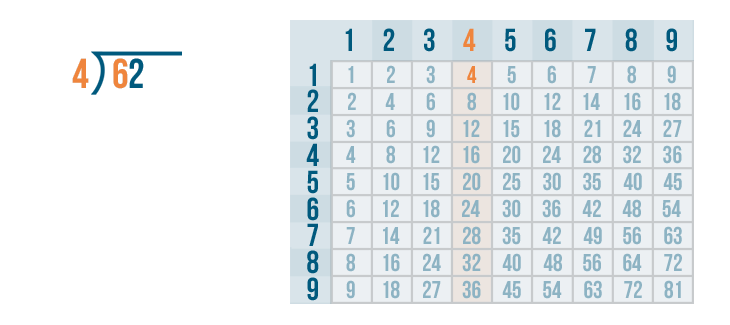
4 is the closest to 6.
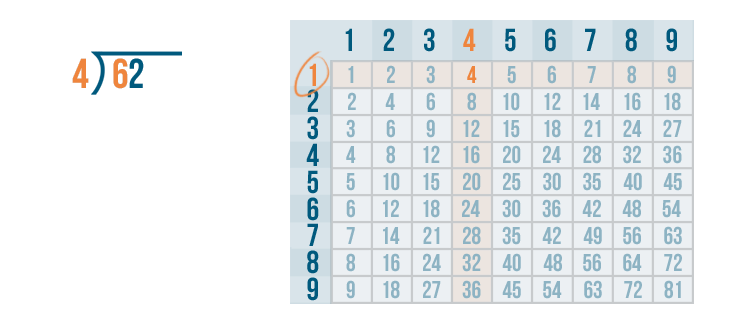
Next, we'll find the row 4 is located in. It's the 1's row.
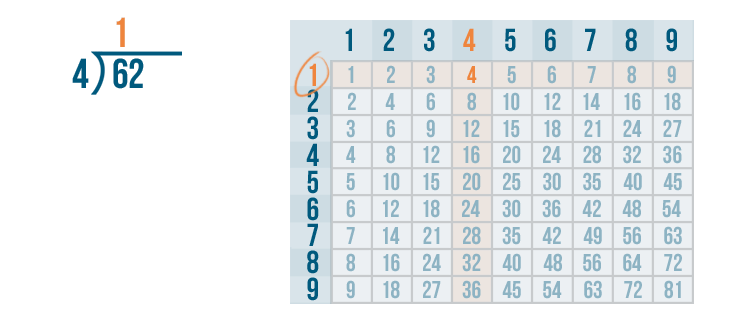
That means 4 goes into 6 one time. We'll write 1 above the 6.

Next, we'll multiply the 1 and 4.

Remember, whenever you multiply a number by 1, that number always stays the same. So 1 x 4 is 4.

We'll write 4 below the 6.
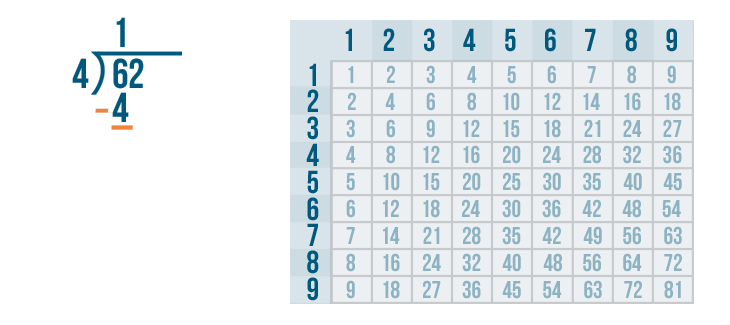
The next step is to subtract.

Now we solve 6 - 4.

6 - 4 is 2. We'll write 2 below the line.

Since 2 is more than zero, we know we're not done with our problem.

We'll bring the 2 down and rewrite it next to the 2.

22 is large enough to be divided, so we'll figure out how many times it can be divided by 4.

Let's look at the 4's column to locate the number closest to 22. The number can't be any larger than 22.
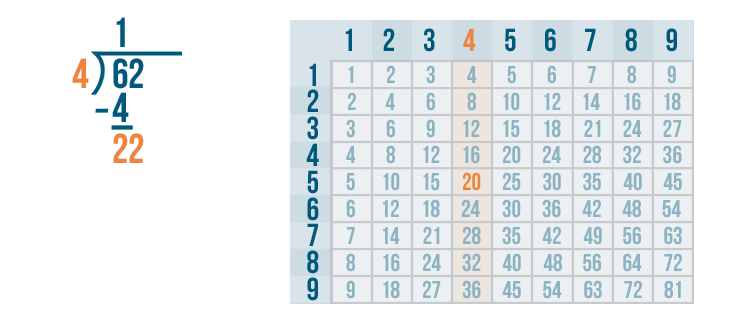
20 is the closest to 22.
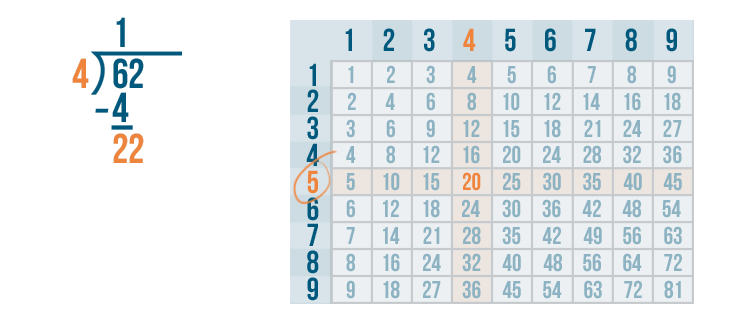
Now we'll find the row 20 is located in. It's the 5's row. So 4 goes into 20 five times.

We'll write 5 above the 2.

Now we need to multiply the 5 and 4.

5 x 4 is 20.

We'll write 20 beneath the 22.

We'll set up our subtraction problem.
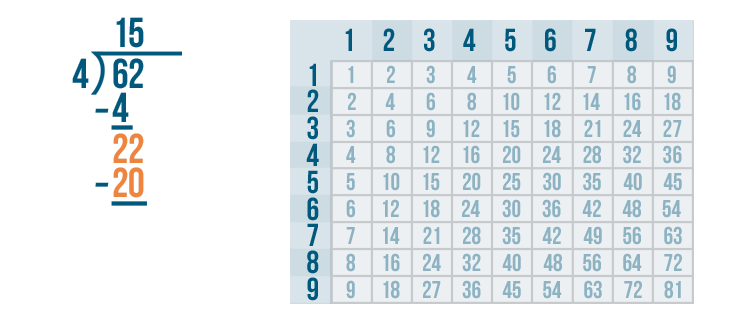
Now it's time to solve 22 - 20.

22 - 20 is 2. We'll write 2 beneath the line directly below the 2 and 0.

The answer to the last subtraction problem is more than zero, so we'll look under the bracket to see if there is another digit we can bring down.

We've divided both of those digits. That means there are no more digits to bring down. But if we write another digit next to 62, we could bring that digit down.

We don't want to make the 62 any larger. That would change our problem. We only had 62 bones to divide.

So next to the 62, we'll write the number that means nothing: 0.

But that changes 62 into a larger number: 620. That won't work.

So to keep the value of 62 this same, we'll add a decimal point between the 62 and the 0.

This means our quotient needs a decimal as well. So we'll write a decimal point next to the 15 directly above the other decimal.

Now we can continue to solve the problem. We'll bring the 0 down and rewrite it next to the 2.
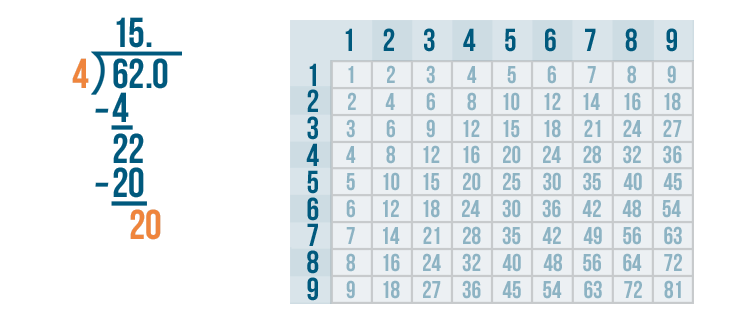
Let's figure out how many times 20 can be divided by 4.

Look at the 4's column. 20 is the number we are dividing, so we'll find the number that is the closest to 20 but not larger than 20.

The 4's column has a 20. That's as close as we can get!

Now we find the row 20 is located in. It's the 5's row. 4 goes into 20 five times.
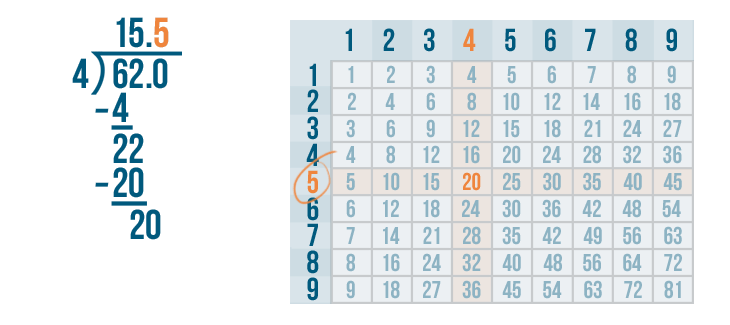
We'll write 5 above the 0.

Now it's time to multiply the 5 and 4.

5 x 4 is 20.

Write 20 beneath the 20.

We'll set up our subtraction problem.

Time to solve 20 - 20.

20 - 20 = 0. Write 0 below the line directly below the 0 and 0.

The answer to the subtraction problem is 0. That means we have completed the problem. So 62 / 4 = 15.5.

Sometimes, you may notice that a decimal can start to repeat as you continue to add zeros under the division bracket. This is known as a repeating decimal. When this happens, you can place a horizontal line over the digit that repeats.
Look at the image below. A horizontal line has been placed over the repeating digit.

Another way to handle a repeating decimal is to round it. Rounding creates a new number that has a value close to the original number.
When rounding a repeating decimal, you'll reduce the number of digits that come after the decimal point. First, decide which digit you are rounding to. Then look at the digit to the right of it. If the digit is 5 or more, increase the rounded digit by 1. If it is 4 or less, the rounded digit stays the same. The other digits after the rounded digit are not written.
Look at the image below. In this case, each of these repeating decimals has been rounded to the second digit after the decimal point.

Now click these and try it. Find the decimal quotient for each of the long division problems below. The answer will automatically be rounded for you.
Problem 1
Problem 2
Problem 3




















































